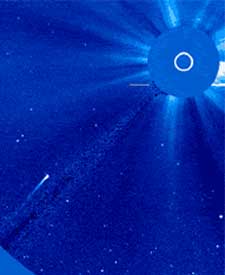
Comet Machholz 1 (96P) sweeps past the Sun on January 7th, just one day before its perihelion. This image, recorded by the Solar and Heliospheric Observatory, shows the comet's bright nucleus and tail. The white circle represents the Sun's hidden disk, and Venus is to the Sun's lower right. Click on the image to see an animation of the comet's motion (456K).
Courtesy SOHO/LASCO Consortium; Sky & Telescope animation by Sean Walker.
Right now the periodic comet known as Machholz 1 is its closest to the Sun, just 19 million kilometers away. Human eyes cannot see the rendezvous, because the comet is positioned just a few degrees from our star in the sky. But if we could, we'd be dazzled — the comet's near-solar experience has turned its icy nucleus into a fizzing factory of gas and dust that has spawned a tail several degrees long.
Fortunately, the NASA/ESA Solar and Heliospheric Observatory has captured the comet's arrival. The spacecraft's Large Angle and Spectrometric Coronagraph, which continuously monitors conditions in the solar corona, picked up the comet in its wide field of view yesterday and has recorded its passage in a remarkable series of images.
When amateur skygazer Don Machholz discovered this comet in May 1986, astronomers initially thought it would make one quick pass through the inner solar system and then disappear forever. But they soon realized that Machholz's find was a periodic comet that orbits the Sun every 5.3 years, traveling in a looping trajectory that extends beyond the orbit of Jupiter. "This is really a remarkable orbit," observes Daniel W. E. Green (Harvard-Smithsonian Center for Astrophysics), in that the comet spirals a little nearer to the Sun at each perihelion then evolves outward over a 4,000-year-long cycle. By the year 2450, should Machholz 1 survive that long, it will pass only 5 million km (0.03 astronomical unit) from the Sun.
 0
0
Comments
You must be logged in to post a comment.